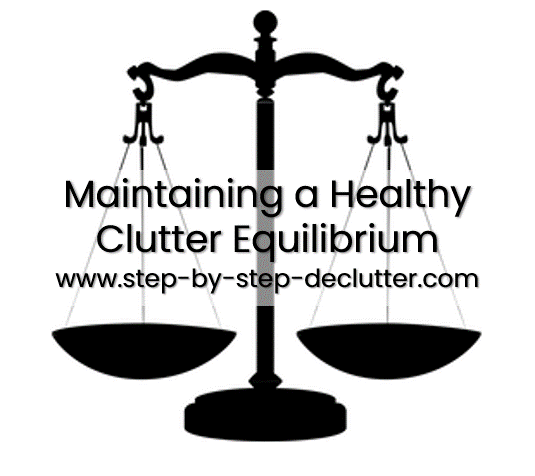|
|
|
Equilibrium can be defined as "a state in which opposing forces or influences are balanced." Clutter equilibrium is an idea I stumbled upon while talking with my husband about the concept of maintaining order once a space has been decluttered. Think of clutter equilibrium as the balance between an orderly space and incoming clutter. I've written a lot about how to declutter, but it's also important to think about maintaining a clutter-free (or significantly clutter reduced) environment. That is the key to long-term success. So here are a few simple ideas for maintaining a healthy balance between clutter and...clarity. Stop Clutter Before It EntersEvery day we're bombarded with potential clutter: free samples, junk mail, brochures, fliers, invitations, catalogs, kids' paperwork (to include artwork), etc., etc. etc. Sometimes it is thrust upon us, and sometimes we invite it in, either consciously or unconsciously. Unconscious clutter includes the many seemingly innocuous bits of paper listed above. We pick up a brochure or flier because we're interested in whatever it's advertising. We receive an invitation in the mail Our kids bring home an information sheet about an upcoming school or sports activity. These things are all innocent enough...until they start to pile up. Conscious clutter is the stuff we choose to bring into our homes to stay - the new DVD or book or board game to add to our collection, the new kitchen gadget, the six bottles of our favorite shampoo that we found on sale. All of these things are perfectly normal and acceptable. We need access to information. We're going to get new stuff. But if all we ever do is bring stuff in without thought, our clutter equilibrium will quickly become a clutter imbalance. Here are some suggestions for stopping clutter before it enters:
Establish and Maintain Systems for DeclutteringSometimes clutter results from things being out of place or not having a place. You can solve these types of clutter problems by setting up and maintaining systems to keep things organized. A system is simply a way of doing things. I've written about the process of developing simple systems here. We've all heard Benjamin Franklin's famous saying "a place for everything, and everything in its place." It's a simple, yet profound solution for preventing clutter. It's also an example of this concept. Having a designated place to puts things constitutes a basic system. Almost everyone struggles with paper clutter in one form or another. While there are ways to limit the amount of paper that comes into or stays in our homes, there are also many papers that we want to hang onto for reference purposes. I've developed a simple three binder system for organizing paperwork. You can read more about it here. Develop a Decluttering MindsetOne of the best ways to maintain a healthy clutter equilibrium is to develop a decluttering mindset. Make decluttering a habit, something that comes naturally to you. Here are some examples of what it means to have a decluttering mindset:
Clear a space for collecting items you wish to donate in your garage or mud room or some other out of the way space. Once a quarter (or whenever the space is full) gather up the items and take them to the thrift store. People often talk about the need for maintaining balance in their lives. It's something we're all striving for. Clutter is one way in which a person's life can become out of balance. Decluttering is just half the battle when it comes to righting the situation. These simple suggestions can help you maintain your clutter equilibrium long-term.
3 Comments
Leave a Reply. |
Archives
November 2022
Categories
All
|
Proudly powered by Weebly



 RSS Feed
RSS Feed